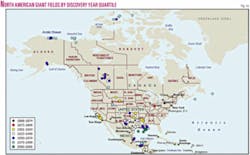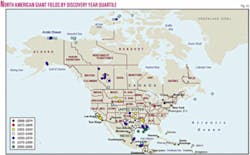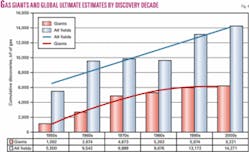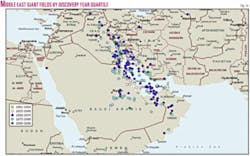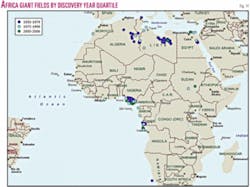Giant fields (estimated ultimate recovery of 500 million bbl of oil and-or 3 tcf of gas or more) exist in every major region of the world, and have been discovered throughout the history of the petroleum industry (Figs. 1a to 1g).
The seven world regional maps represent 15 decades. The period extends from 19th century discoveries dependent on oil seeps and surface structures, drilled and produced with minimal technology; to 21st century discoveries dependent upon sophisticated geophysical tools and elegant geologic models and highly technical drilling and production techniques.
No better example of the application of modern production technology is found than at the largest oil discovery of the present decade: Kashagan field in the Caspian Sea off Kazakhstan,1 presently being developed under harsh conditions of the environment, complicated by high concentrations of hydrogen sulfide.2
Kashagan is expected to recover 13 billion bbl of oil. To be developed in phases, its expected production steps are 75,000 b/d at first, gradually increasing to 450,000 b/d, and ultimately reaching 1.2 million b/d.
Of the 33 giant oil field discoveries in the decade that began with the year 2000 in addition to Kashagan, the following are the most important: Block 15 Complex, including Kizomba, Angola; Hosseinieh, Iran: combined fields of the deepwater Lower Tertiary (Walker Ridge) Trend, Gulf of Mexico, US; Kushk, Iran; and Southwest Bonga, Nigeria.
One of the largest giant gas discoveries this decade, Jansz field off Northwest Australia, illustrates application of modern day exploration techniques, in this case to detect stratigraphically trapped dry gas by targeting amplitude-supported seismic anomalies.3
Of the 39 giant gas field discoveries this decade in addition to Jansz, the following are the most important: Kish and Lavan, both in Iran; Sulige, China; Karan, Saudi Arabia; and Mexilhao, Brazil.
Most of the 72 giant fields discovered this decade owe their status to the application of technologies that were not available in the early and middle history of the industry.
The objective of this study, which will be presented next week in the second and final part of this article, is to show in mostly graphical form the major patterns in decade-by-decade format of giant field discoveries, ultimate reserves, and average field size. Estimates of giant field percentage contribution to the global hydrocarbon inventory will also be presented.
The major source of data for this study is Horn4 supplemented with additional information for the present decade.
Next: Giant fields are likely to supply more than 40% of the world’s oil and gas.
